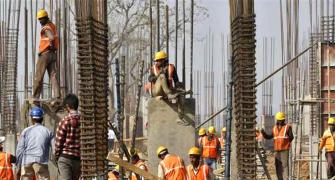It is not a good idea to take the line that since demonetisation happened in the third quarter, everything that happened then was a consequence of that, says Chief Statistician TCA Anant.

As critics doubt the gross domestic product (GDP) figures brought out by the Central Statistics Office (CSO), Chief Statistician TCA Anant tells Indivjal Dhasmana that demonetisation-like events take time to work through the economy.
READ: GDP belies note ban fears; economy grows at 7%
 The CSO, Anant, left, says, has given the figures based on methodologies and it is crucial to understand those rather than speculating.
The CSO, Anant, left, says, has given the figures based on methodologies and it is crucial to understand those rather than speculating.
Both the first advance estimates, which did not factor in the impact of demonetisation, and the second advance estimates, which accounted for the effect of the note ban, gave the same gross domestic product growth numbers at 7.1 per cent for 2016-17. Similarly, the third-quarter growth figure was high at 7 per cent. Do we conclude that demonetisation did not have any impact on the economy?
Events such as demonetisation, which are a large policy change, are not assessed by single-quarter data. These have many effects and will take time to work their way through the economy. A simple post hoc one-quarter number cannot assess these impacts.
But yes, the third quarter was a period when demonetisation was announced. More than that, I am not going to draw any further conclusions.
Do you agree with your predecessor Pronab Sen’s argument that GDP growth was high in the third quarter due to channel stuffing -- manufacturers sell their products to wholesalers and dealers but these were not sold to consumers?
You can talk about only what is available in the figures. The rest is all a matter of assumption.
One figure we have is manufacturing performance, which is gauged by the third-quarter financial performance reported by companies, inter alia manufacturing companies.
The second is the index of industrial production (IIP) numbers. Between these two, we essentially assess manufacturing.
Trade is assessed largely by volumes, which are derived from the sales tax collection data available with states, and some part through the profits of these companies.
Other than these, what has happened -- whether inventories were piled up -- is not possible for me to speculate. I can tell you what the information is -- sales tax collections have gone up and companies have reported a better financial performance in the third quarter.
Even though the GDP numbers are the same in both the advance estimates for 2016-17, gross value added (GVA) growth was lower at 6.7 per cent in the second estimates than 7 per cent in the first estimates. Also GVA expansion was at 6.7 per cent in the third quarter against 7 per cent a year ago. In a way, there was some impact of demonetisation, isn’t it?
It is not a good idea to take the line that since demonetisation happened in the third quarter, everything that happened then was a consequence of that.
That is a cause and effect analysis which I have considerable discomfort with.
The reason for the divergence between the GDP and GVA figures is explicable in the behaviour of indirect taxes net of subsidies.
Critics have pointed out that the CSO has not gauged the impact of demonetisation on the unorganised sector. How do you account for that?
The CSO gauges the unorganised sector through a set of indicators.
A large part of the unorganised sector in India is in agriculture. Agricultural estimates are derived through acreage and yield estimates, which are converted into GVA through studies on the cost of cultivation.
The second category is construction, in which, again, we do not have direct estimates of value added but indirect estimates based on the consumption of inputs such as cement and steel.
The third element is trade, for which we assess the value added through indirect estimates of volumes, derived from tax collection figures.
The other segment in which the unorganised sector is present is manufacturing, in which assessments are made on the basis of the IIP data. By its character, the unorganised sector does not have regular accounts.
This is how we capture the unorganised sector in all times. In the absence of anything else, you can speculate. You could have said so in the past as well, so why only now?
In 2015-16, GDP growth was revised from 7.6 per cent to 7.9 per cent after the first advance estimates. Despite this high base effect, the second advance estimates gave the same number as the first one. Why is it so?
The way that projection is done is indicator-based. Indicators are applied to a base. All quarterly and advance estimates are what are called benchmark indictor estimates.
While the base has changed in the revised estimates, indicators remain the same in both the advance estimates for the current year.
So, the behaviour of the current data is partly the behaviour of the benchmark and partly the behaviour of indicators.
In other words, if the second advance estimates were based on the earlier figure of 2015-16, they would have shown a higher GDP figure than the 7.1 per cent for 2016-17. Isn’t it?
It is not as simple as that. It is not as straightforward.
There is a wide perception that demonetisation has dented demand, but private final consumption expenditure grew 10 per cent in the third quarter, which was double the 5 per cent in the second quarter. How could that be?
Remember that we do not have any data on private consumption. It is assessed from the production estimate through a set of indicators and ratios.
Principally the components of private consumption are food, services such as government education and health, and manufacturing, durable and non-durable.
If you look at the performance of these components in the third quarter, and find that production has gone up and a certain portion of that production ends up in consumption, consumption must have also gone up.
Are the GDP growth numbers high in the third quarter also because digital transactions rose after demonetisation?
The data used are not based on electronic transactions versus non-electronic transactions.
All we can tell you is what the figures are. After that you are free to speculate because you don’t have the figures for those. That level of granularities is not available.
Photograph: Reuters.










